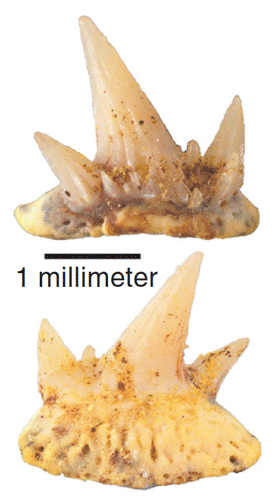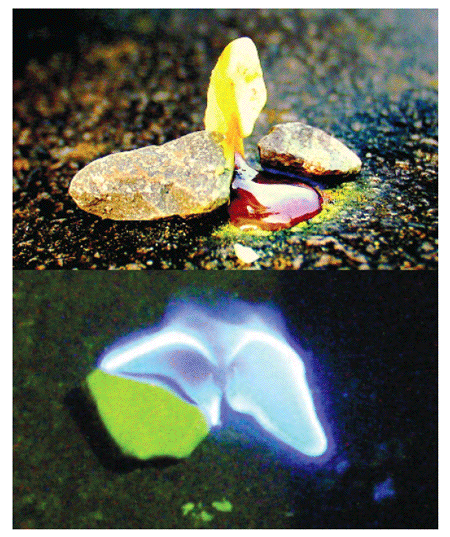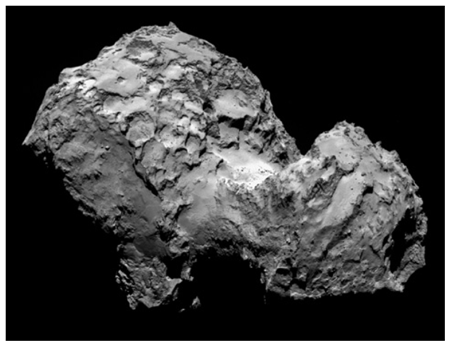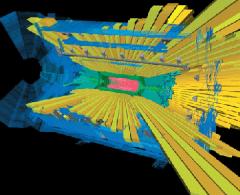
This Article From Issue
September-October 2015
Volume 103, Number 5
Page 316
DOI: 10.1511/2015.116.316
In this roundup, associate editor Katie L. Burke summarizes notable recent developments in scientific research, selected from reports compiled in the free electronic newsletter Sigma Xi SmartBrief. Online: https://www.smartbrief.com/sigmaxi/index.jsp
Shark Fossil with Bone Cells?
A fossil of an early shark found in Western Australia is causing paleontologists to rethink the evolution of bony skeletons. The 380-million-year-old fossil included a lower jaw with teeth, scales, and parts of the shoulder girdle. Few shark remains have been found from this period, especially of this quality, so this specimen will serve as a window into vertebrate evolution. Bony skeletons have long been thought to have evolved from cartilaginous skeletons, such as those of sharks. However, amid the cartilaginous skeleton of this fossil, paleontologists found vestigial bone cells. They think this finding shows that sharks at this time were in transition from a bony skeleton to a cartilaginous one, implying that bone evolved first.

Image courtesy of PLoS ONE.
Long, J. A., et al. First shark from the Late Devonian (Frasnian) Gogo Formation, Western Australia sheds new light on the development of tessellated calcified cartilage. PLoS One doi:10.137/journal.pone.0126066 (May 28)
Kennewick Man’s DNA Analyzed
A genomic study settles a debate about whether a controversial 8,500-year-old human skeleton, known as Kennewick Man or the Ancient One, was of Native American or European descent. After the remains were found near Kennewick, WA, in 1996, several Native American tribes claimed the body was their ancestor and deserved a ritual burial. Some archaeologists responded that his skull shape more closely resembled that of Europeans. Using methods to gather ancient DNA, scientists assembled Kennewick Man’s genomic sequences for comparison with that of other ancient and modern humans. The analysis showed that Kennewick Man’s DNA most closely matches modern Native Americans. Among the DNA available, Kennewick Man’s most closely matched that of the Colville, one of the tribes claiming him as their ancestor. The analysis also illuminated ancient human migration patterns in the Americas. Kennewick Man and the Colville belong to a branch of Native Americans that spread across North America. Kennewick Man’s DNA was compared to a 12,600-year-old skeleton found in Montana, known as the Anzick child. The analysis shows that the Anzick child belongs to another branch of Native Americans, who migrated to Central and South America. The split between these two branches must have happened quite early in the peopling of the Americas. Although some of the science is settled, there is still much to be discussed about what to do with Kennewick Man.
Rasmussen, M., et al. The ancestry and affiliations of Kennewick Man. Nature doi:10.1038/nature14625 (June 18)
Sulfur in Earth’s Core
Geochemists studying the formation of Earth’s core think it may contain large amounts of sulfur. Seismic studies of the core indicate it is less dense than expected from its inferred composition of heavy elements such as iron and nickel. By comparing copper isotopes from meteorites—thought to be Earth’s building blocks—and from rock from the mantle, researchers found that lighter copper isotopes were not present in the mantle at the quantities indicated by the meteorites’ composition. They think that processes deep within the Earth, including the separation of the planet’s layers, sent the light copper isotopes down to the boundary between mantle and core, forming a kilometers-thick layer of material with other elements. The researchers estimate that about 90 percent of Earth’s sulfur is in this layer.

Wikimedia Commons
Savage, P. S., et al. Copper isotope evidence for large-scale sulphide fractionation during Earth’s differentiation. Geochemical Perspectives Letters doi:10.7185/geochemlet.1506 (June 4)
Lightning Sprites Explained
Atmospheric science research has unveiled the mechanism behind rare phenomena called lightning sprites that occur high up in the atmosphere during thunderstorms. These elusive displays, red-orange explosions lasting only a few milliseconds, are associated with the most powerful lightning strikes. Using two high-speed cameras attached to an aircraft, Ningyu Liu of the Florida Institute of Technology caught the process on film. Liu showed that the sprites are caused by atmospheric gravity waves that grow in the electric fields produced by lighting.
Liu, N., et al. Sprite streamer initiation from natural mesospheric structures. Nature Communications doi:10.1038/ncomms8540 (June 29)
Cause of Comet’s CO2 Plumes
Electrons, not photons as once thought, are causing water and carbon dioxide molecules to break up in the atmosphere around comet 67P/Churyumov-Gerasimenko, according to data collected by the Rosetta probe. As a comet approaches the Sun, it heats up and emits plumes of water and carbon dioxide. These gases combine with dust to form comets’ distinctive fuzzy atmosphere and tail. Using the Alice ultraviolet spectrograph, Paul Feldman of Johns Hopkins University found that he and his team could not see atoms split by ultraviolet rays, as expected. Instead, they saw energetic electrons that break off lone atoms of oxygen, hydrogen, and carbon close to the comet’s surface. It’s likely the energetic electrons were stripped from other molecules by photons from the Sun’s ultraviolet light. Astronomers once thought that comets spewed ice and dust from all over their surfaces, but these substances actually emerge only in gas plumes, which vary in molecular composition. Observing the distribution and composition of these plumes and relating them to a comet’s surface features should help astronomers understand how comets once formed billions of years ago.

Image courtesy of ESA/Rosetta/MPS for OSIRIS Team MPS/UPD/LAM/IAA/SSO/INTA/UPM/DASP/IDA.
Feldman, P. D., et al. Measurements of the near-nucleus coma of comet 67P/Churyumov-Gerasimenko with the Alice far-ultraviolet spectrograph on Rosetta. Astronomy and Astrophysics doi:10.1051/0004-6361/201525925 (June 2)

American Scientist Comments and Discussion
To discuss our articles or comment on them, please share them and tag American Scientist on social media platforms. Here are links to our profiles on Twitter, Facebook, and LinkedIn.
If we re-share your post, we will moderate comments/discussion following our comments policy.